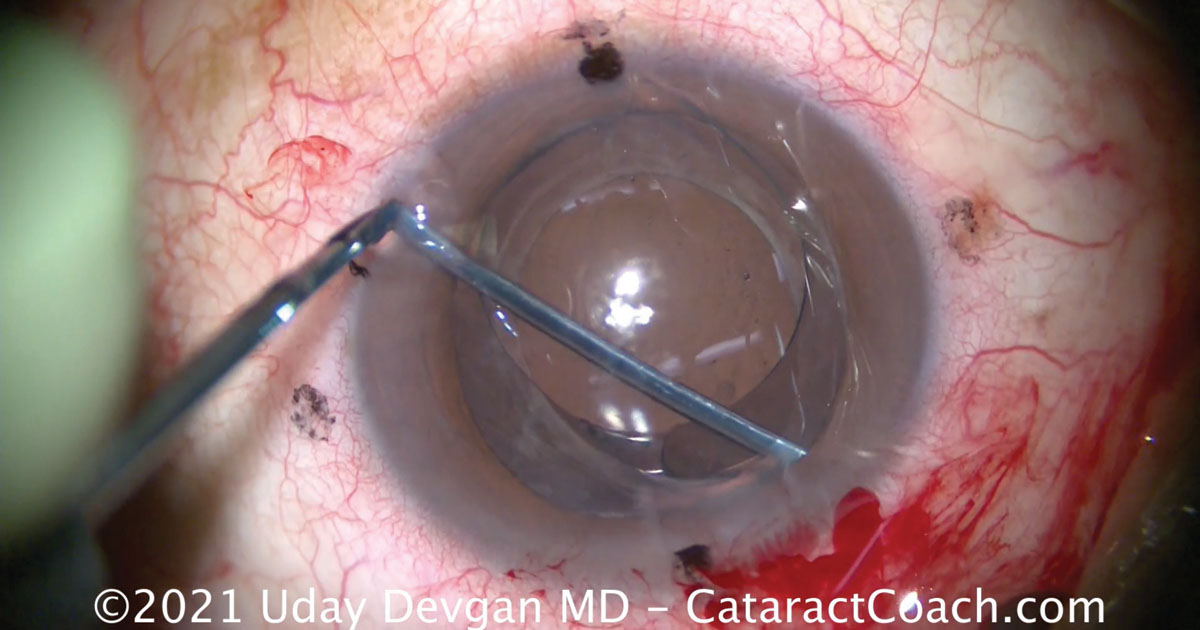Stuck haptic poses challenge during IOL exchange
While it is rare, there are some patients who will benefit from an IOL exchange.
The reasons may include a desire to change the IOL power or, in this case, to change the type of IOL. It is easier to perform the IOL exchange in the week or two after the original cataract surgery, but it can still be done safely months or years later with care taken to free the haptics from their attachments to the capsular bag.

In the case presented here, a patient who has high demands for his vision sought to address the issue of presbyopia in his mid 50s. He elected to have a refractive lens exchange and implantation of a trifocal IOL. This surgery was performed about a month ago by a different surgeon, and then the patient contacted me when he realized that he could not live with the inherent compromises of a trifocal IOL. There is a risk in doing a refractive lens exchange with a trifocal IOL on a plano presbyope because, while the near vision may improve on acuity testing, the quality of the vision may be worse. These patients want to have near vision that is as good as or better than they have now with reading glasses. This is in contrast to patients with cataracts who have decreased acuity and lower quality of vision due to the lens opacities. For those with cataracts, just about any IOL will be an improvement in terms of visual acuity and quality of vision.
Because this patient needs the highest image quality for his work, he is unable to tolerate the sacrifices of a trifocal IOL. By splitting the incoming light into near, intermediate and far vision ranges, there is a sacrifice in the image quality. He is certain that he desires an IOL exchange with a monofocal IOL instead. He is about 1 month out from his original surgery, and the capsular bag has already contracted and partially fibrosed.
One of the biggest challenges for this type of IOL exchange is how to carefully dissect the IOL from the capsular bag without damaging the delicate capsular tissue. The capsular tissue is thin and delicate, just 4 µm for the posterior capsule and about 14 µm for the anterior capsule. This IOL design features a haptic with a bulbous tip at the end, and that is more of a challenge to remove.
Viscodissection can be helpful to separate the optic from the posterior capsule. Using a 27-gauge needle, viscoelastic can be injected under the anterior capsular rim to elevate it. Then, this is switched to a 27-gauge blunt cannula to inject more viscoelastic until a wave is seen going across the posterior aspect of the optic. If the anterior and posterior capsule surfaces can be fully separated using this technique, then the IOL is free enough to explant.

Source: Uday Devgan, MD
In this case, however, the capsular contraction is strong, and the bulbous tip of the haptic is firmly adherent to the capsular bag (Figure 1). It is imperative that force is avoided in this situation. While it may be tempting to just yank on the haptic, this will likely result in capsular damage including loss of zonular support. More viscoelastic is injected to further inflate the capsular bag, and then careful dissection can be performed.
Using a spatula through a paracentesis incision opposite the site of haptic-capsule adherence, circumferential movements are used to separate the anterior and posterior capsule surfaces (Figure 2). This is performed in small steps because we want to minimize any potential damage to the delicate capsular tissue. Once this is complete, the haptic should be free, and then the entire IOL can be brought up out of the capsular bag and into the anterior chamber where it can be explanted (Figure 3).


The IOL is then removed using the twist-and-out technique, which we have previously detailed in this column, through a 2.75-mm wide incision. We also placed this incision on the patient’s steep corneal axis in order to address the astigmatism. A monofocal IOL is placed into the capsular bag with a refractive goal of plano. The healing process in these cases is slower and more involved than the original surgery, but with time, these patients can achieve a great outcome. This patient returned to 20/20 distance vision and is happy with the outcome. Even though he is back to wearing his reading glasses, the patient is much happier with the increased quality of vision.
See full video of this case at cataractcoach.com.
- For more information:
- Uday Devgan, MD, is in private practice at Devgan Eye Surgery, Chief of Ophthalmology at Olive View UCLA Medical Center and Clinical Professor of Ophthalmology at the Jules Stein Eye Institute, UCLA School of Medicine. He can be reached at 11600 Wilshire Blvd. #200, Los Angeles, CA 90025; email: devgan@gmail.com; website: www.CataractCoach.com.
